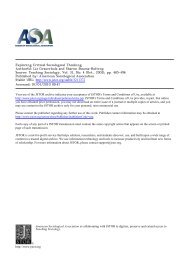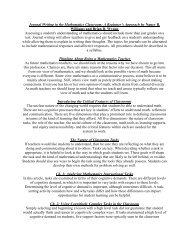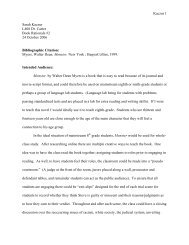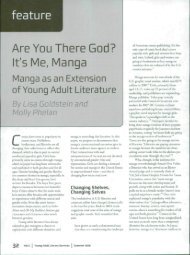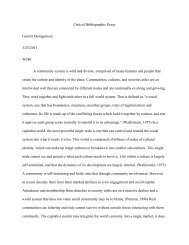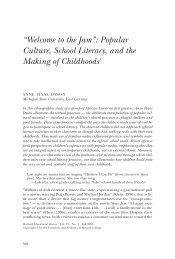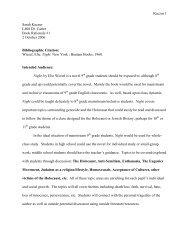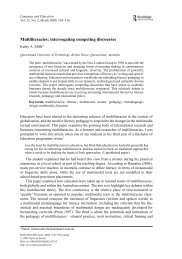A road map for reading specialists entering schools ... - Oncourse
A road map for reading specialists entering schools ... - Oncourse
A road map for reading specialists entering schools ... - Oncourse
Create successful ePaper yourself
Turn your PDF publications into a flip-book with our unique Google optimized e-Paper software.
multiple methods to identify students' strengthsand weaknesses in <strong>reading</strong>. Third, I offered a coregroup of strategies to the teachers that they coulduse to build on students' strengths and address theirneeds. Fourth, I selected and offered curriculummaterials and resources. In the following sectionsI explain how each goal was addressed.Helping teachers reconceptualize theiriiteracy instructionThe attempt to get the teachers to reconceptualizetheir literacy instruction beyond their existingbeliefs converged on a dialectic between therole of literacy instruction <strong>for</strong> African Americanshistorically and the present authority given to standardizedtests to control literacy instruction. Thereconceptualization focused on several dominantthemes <strong>for</strong> the teachers that included getting themto (a) engage their students with authentic text andin authenfic discussions where the students couldanalyze their realities in the context of the curriculum;(b) use meaningful literacy activities that addressstudents' cognitive and affective domains,taking into account students' cultural characteristics;(c) acknowledge that skill development, increasingtest scores, and nurturing students'cultural identity are fundamentally compatible; (d)make African American students" culture a reference<strong>for</strong> learning; and (e) resist curriculum orientationsthat stifle or postpone academic growth.Developing a comprehensiveassessment profileThe University Partnership Team and theteachers entered school year 2001-2002 with alimited profile of the students' <strong>reading</strong> abilities. Wewere given a school progress report that indicatedhow well the students per<strong>for</strong>med on the ITBS.There were no other assessments to provide a collectionof evidence about students' strengths andweaknesses with <strong>reading</strong>. The test data were notuseful <strong>for</strong> making instructional decisions. Theyonly indicated that the teachers' practices, primarilyaimed at increasing test scores, were marginallyeffective at best. The University Partnership Teamdecided that our assessment profile needed to bestrengthened.To ensure that students get the help they need,appropriate assessments should be used to idenfifythe specific strategies and skills the students possessand their response to instructional practices. This isvital to responsive teaching, and even more so <strong>for</strong>students who struggle with <strong>reading</strong>. Also, an effectiveassessment plan is one that is ongoing, involvesboth in<strong>for</strong>mal and <strong>for</strong>mal measures, and extendsacross several areas of <strong>reading</strong>. There<strong>for</strong>e, there wasa need to develop an assessment profile of students'strengths and weaknesses and the instruction theywere receiving to respond to their needs.Several types of assessments were used to identifystudents' strengths and weaknesses related to<strong>reading</strong>. The first assessment, completed in October2001, was a decoding exercise using graded wordlists from the Qualitative Reading Inventory-Ill.This assessment procedure was selected to gather aquick estimate of students" abilities to decode wordsin isolation. The results indicated that more than70% of the students at each grade level were ableto decode words at their grade level with 90% accuracyor better. However, the results also indicatedthat less than 10% were able to decode the wordsautomatically (when they were flashed <strong>for</strong> one second).The results of this assessment were corroboratedlater with other <strong>for</strong>ms of assessment todetermine how students attempted to decode wordsin context that were unfamiliar to them.Second, classrooms were observed <strong>for</strong> twomonths to identify patterns of literacy behaviorsand instructional practices that could be sharedwith classroom teachers. Oral <strong>reading</strong> miscues,notes about students' engagement with the text, andstudents' responses to comprehension questionswere recorded. Analysis of this data indicated thatthere was often a question-answer mismatch whenstudents attempted to answer questions. In manycases, the students could not provide the rationale<strong>for</strong> their responses—they were passively engagedwith the text. Many of the students struggled withthe vocabulary in context although the teacher provideda definition.Observation of the instructional practices revealedthat students were not being held individuallyaccountable <strong>for</strong> comprehension on a dailybasis. Word study and vocabulary developmentwere different in each classroom. Individual correctivefeedback was sparse. Also, there was a mismatchbetween the type of questions the studentswere asked to answer in class and the type of ques-A <strong>road</strong> <strong>map</strong> <strong>for</strong> <strong>reading</strong> <strong>specialists</strong> <strong>entering</strong> <strong>schools</strong> without exemplary <strong>reading</strong> programs



